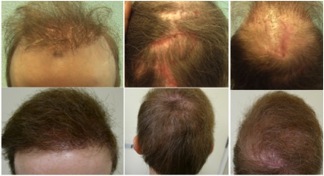
SEVERE HAIR LOSS
There are a few causes of severe hair loss that qualify a person for body hair transplant, including:
- Advanced male pattern baldness
- Depleted donor source from prior hair restoration surgeries
- Extreme hair loss from an accident or burn
Male Pattern Baldness
Male pattern baldness is the leading cause of hair loss for men. It is currently afflicting 40 to 50 million men inside the United States alone. The condition gets passed from generation to generation through the maternal or paternal X chromosomes, resulting in weak androgen receptors that leave certain scalp hair vulnerable to the hormone DHT. The miniaturizing effects that DHT has on each hair follicle can eventually lead to complete baldness. While a strong family history may foretell the cosmetic fate that is to come, nothing can prepare a person for the emotional hardship of extreme hair loss. Today, body hair transplant images show these men that there is still hope for successful restoration.
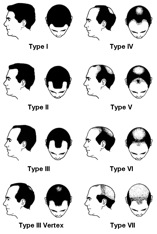
Other Causes
BHT is also commonly used as a repair surgery. Whether the repair covers scars from a prior botched surgery, accident, or burn, these patients have suffered a depletion of all or the majority of scalp donor hair. Typical botched surgeries that exhaust scalp donor supply and cause further disfigurement with scarring have included:
- Scalp reduction
- Temporoparietal-occipital flap surgery
- Punch grafting
- Strip harvesting (FUT)
These procedures often lead to slot formation, unnatural hairline, “doll’s hair,” punch scars, and linear scars. These failed surgeries necessitate correction using non-head hair.
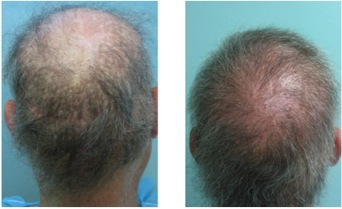
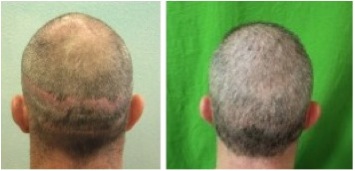
HAIR RESTORATION WITH BODY HAIR TRANSPLANT
Body hair transplant uses the follicular unit extraction (FUE) technique as its base. FUE, developed in the 1990’s, harvests donor hair individually with a .8-1.2mm punching mechanism. Successful body hair transplant images demonstrate that this method does not use any scalpels, requires no wound sutures, and results in fast healing.
Due to the minimal invasiveness of this technique, almost every area of the body is capable of serving as a donor source, including the beard, shoulders, stomach, arms, legs, and chest. And with different areas yielding hair of varying calibers, certain body hairs become ideal to achieve an aesthetically superior result. For example, the fine quality of leg hair creates soft, natural-looking hairlines, while the thick nature of beard hair is excellent for adding density.
Furthermore, an advanced body hair transplant surgeon will excise the hairs in such a scattered and diffuse pattern that there is negligible scarring and no bald patches in the donor area.
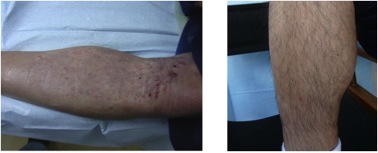
Body Hair Transplant Images
Body Hair Transplant Images of body hair transplant procedure are a crucial resource for any severely bald person considering surgical restoration. These can be in the form of photos or videos.
Being such a groundbreaking procedure and still relatively new, it is not yet a commonly practiced worldwide method. Therefore, finding a surgeon advanced enough to perform successfully may be difficult. Photos and videos serve as proof of a doctor’s expertise, and will guide you in selecting the right one.
The only surgeons capable of carrying out a BHT surgery are FUE surgeons who are adept at using handheld tools. They must have the highest level of training, years of experience, matchless medical skill, and unparalleled artistic aptitude. You will find many doctors who allegedly possess all of these attributes, but they must be able to provide the photos and videos to substantiate their claims of excellence.
Body hair transplant images should display natural-looking hairline creation, intricate crown whorl design, evenly spaced coverage, and satisfying density. The before and after should show a remarkable transformation. But always be wary of clinics that retouch their photos and/or edit their video footage to enhance the results. In addition, images should always be taken in good lighting, with a focused lens, and display multiple angles of the example scalp.
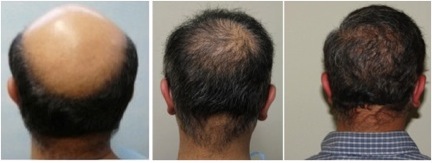
FAQ
Who is a candidate?
Candidates must foremost have a depleted scalp donor source. They must then have adequate body hair as a backup supply. For hair transplant in general, all candidates must not have anesthesia allergies, blood clotting irregularities, or scarring tendencies, must be in good overall health, and be over the age of twenty-four. People with extremely curly hair are not ideal as curved follicles complicate excision.
Are women candidates?
Yes. Body hair transplant images will sometimes show women with adequate leg hair to facilitate body hair transplant.
What are the drawbacks?
The drawbacks of using body hair are that it will always act innately, even after transplant. Thus, hair from the beard will behave like beard hair in growth rate, length, texture, and color, which might not blend perfectly with surrounding scalp hair. Also, the long-term graft survival rate of body hair is not as high as that of donor hair from the scalp.
If you are interested in learning about the background of body hair to head transplant procedures, click here to read more.

